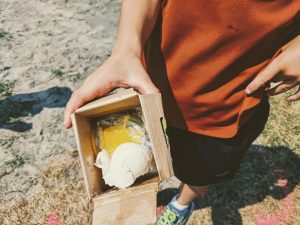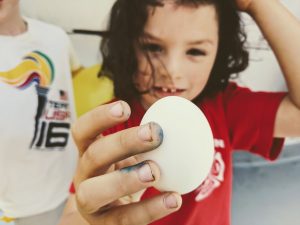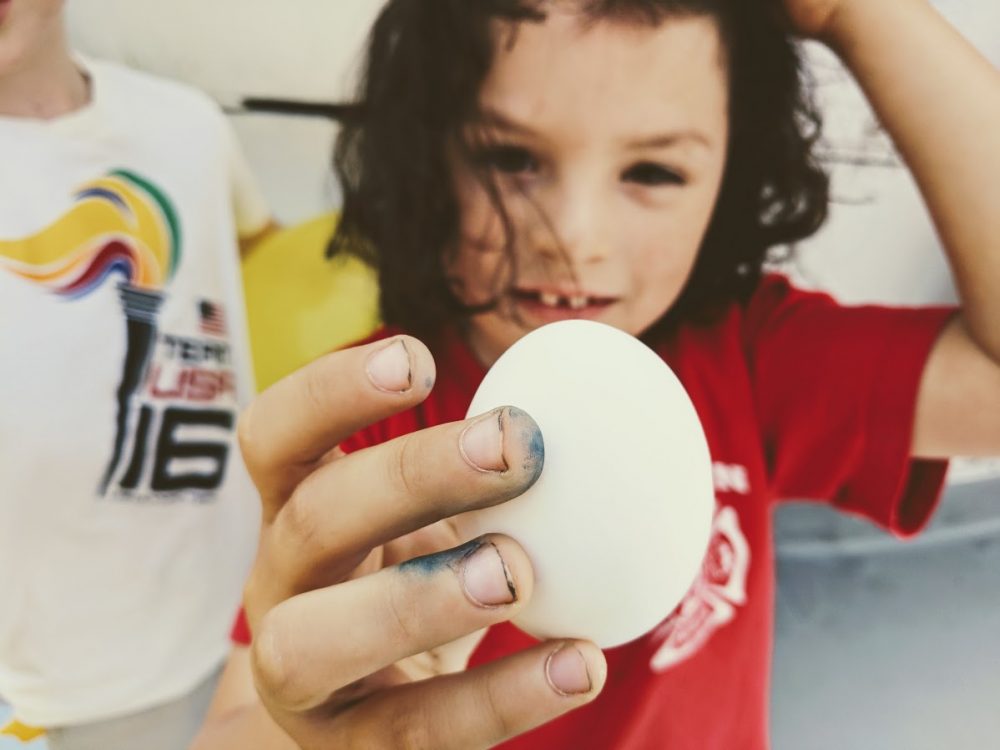A messy engineering challenge that fosters creativity
Egg Drop Challenge for creative afternoons.
The egg drop project is one of those science projects that can really fluster kids. But it also really helps them think outside of the box and apply engineering skills.

You don’t need much for the egg drop science project, not even a high place to drop from.
I’ve done this many times over the years, sometimes we have dropped the eggs from the roof of our local observatory, other times we just stood on a stool and dropped them onto a hard tile floor.
Both times kids found the project incredibly challenging. Very few were successful on their first attempt, which meant they got some practice with the engineering process (ask, imagine, plan, create, improve).
It also gave us a chance to talk about failure, and how failure can teach you.
There are many constraints you can put on your egg drop challenge.
Size, weight, materials, use of parachutes etc can all scale this engineering challenge up for older learners, or down for younger learners. Two egg drop challenge examples are the egg drop challenge with your recycling bin, and the egg drop challenge using only straws and tape. Feel free to choose one, or make your own constraints!
Egg Drop Project Ingredients:
(for first time, or younger, learners)
- Raw eggs
- Full recycling bin
- Tall place to drop your eggs from
Egg Drop Challenge Ingredients:
(for experienced, or older, learners)
- Raw eggs
- Straws
- Tape
- Tall place to drop your eggs from
Tips for a successful egg drop project
- Think about how to buffer the impact
- Create a reusable project
- Use hot glue or duct tape
1. Buffer the egg’s impact

A successful egg drop project means your egg has no cracks on it whatsoever when you take it out. Eggs are fragile. Drop it on its side or its top/bottom with no protection and it will break.
If your egg drop experiment has protection on only one portion of the egg, you need to make sure there is a way to guarantee how the egg will descend to the ground as you are leaving yourself exposed.
You also want to think about how your egg will be buffered. Just before the egg hits the ground it is moving fairly quickly.
When it stops suddenly you need to absorb all of that kinetic energy (the energy of movement), ideally not into your beautiful pristine egg.
What is one big way to absorb a lot of kinetic energy quickly?
Into things that squish. It takes energy to deform a material, so the more material you can put in front of the egg to absorb the kinetic energy through deforming the better chance you have of your egg surviving. Things that squish could include bubble wrap, fabric, cardboard, paper scraps, airbags, straws that break etc.

When I did the egg drop experiment in 6th grade a long long time ago, I used a thick liquid to absorb a lot of the kinetic energy – peanut butter.
2. Create a reusable egg drop project.
Here’s the thing with engineering challenges – they rarely work the first time around. If your egg drop experiment can only be dropped once you won’t have the chance to go back, determine what part of the vehicle failed, and find a solution to make the next drop better.
When I run programs with my kid’s classes the best way I do this is by telling them the egg has to be put in right before the drop. This prevents kids from wrapping them in duct tape – which has absolutely been tried and absolutely does not work. It also makes them think about where the egg will be secured.

Instead of building a project around the egg it helps the kids think about building the project for the egg.
A reusable experiment is also the key to making this a true engineering challenge. Kids should first ask what the goal is.
From there they imagine a solution to keep the egg safe, plan the project, and create it. Finally, they test it and go back through the loop.
They ask why it didn’t work (or maybe why it did work), they imagine a solution to that new problem, plan the changes and create an updated vehicle.
Or maybe a new vehicle entirely if their egg drop project was an utter failure – but the goal is to edit and revise over a variety of trials, not just scrap it every time. You want to save the “trash it” method for projects that really didn’t work.

To be able to critically think about how the failure happened, and create a plan to fix it, you need an egg drop project that can be reused.
Trust me, having a project that you can edit and modify over a variety of trials really does impact their learning. It also helps them find success much faster.
3. Use hot glue or duct tape.
This is good advice for lots of engineering challenges. Why? Because liquid glues take a long time to cure, and they often aren’t nearly as strong as hot glue. Personally, I love hot glue for these types of projects because it is easy to apply, holds really well, is water resistant, and dries quickly.

A good backup to hot glue is duct tape.
Duct tape probably got me my Ph.D. – that stuff can really stick. The problem with duct tape is that it can be hard to get two awkward pieces to join together at odd angles.
With your only resources coming from the recycling bin that can sometimes cause a little frustration.
We want to keep all of their frustration for dealing with, and overcoming failure.



4 thoughts on “Egg Drop Challenge: An engineering based science project”
Comments are closed.